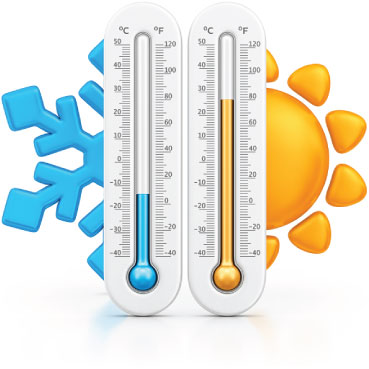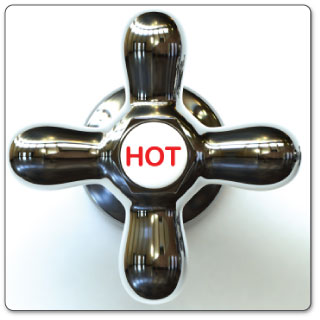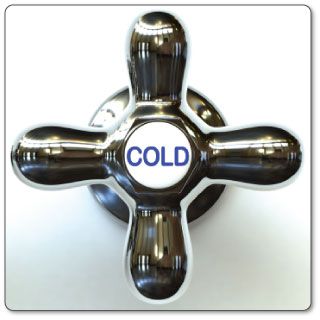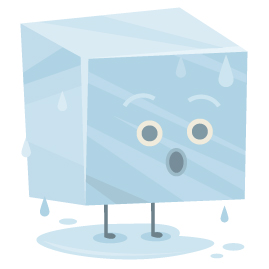When dealing with pain from medial or lateral epicondylitis (tennis elbow or golfer's elbow) it's hard to know what treatment will work best for you. You might be wondering if ice and heat will work for you. Or maybe even which will work better - ice OR heat.
Ice and heat are essentially the 2 most natural treatment options available. Compared to medications, surgery and other treatment methods - icing and heating have been around for centuries and have always been used for tennis elbow and golfer elbow injury healing as a means to soothe and heal.
We understand that it can get pretty confusing to figure out what conservative treatment method will work best with all of the treatment options available to you today. To get started, you should think about the benefits you'll get from using these treatments.
Ice and heat are the best treatment combination for you if:

Combining cold and warmth is a simple yet effective way to get immediate pain relief and promote long-term healing. In your lifetime you've probably had your mom, family doctor, nurse, surgeon or physical therapist tell you to use ice right after you're injured and something warm from time to time once the swelling's gone down. It's a simple yet very effective way to relieve pain and promote healing in your elbow.
Tennis elbow and golfers elbow can happen to anyone, right now there are thousands of doctors and physical therapists dealing with patients that require a solution to treat their elbow injury fast and heal it (where possible).
If you want to be proactive about properly dealing with your elbow injury, speak to your doctor about adding conservative temperature treatments to your recovery through the application of ice and heat.

Your doctor knows that the sooner cold is applied, the quicker you can reduce inflammation and achieve real pain relief. This will help reduce the chance of a much longer lasting chronic injury. Heat and inflammation are a bad mix and should not be used together. Heat is good at the spa - it will help your body relax, but when it comes to an injury it is not a good idea.
A Cold Compress or Ice Pack work best to relieve pain, swelling and inflammation for new injuries, re-injury and during immediate post surgery recovery. Cold should also be used during the first 24 - 72 hours of treatment, combined with resting your injury.
You're having a "good day" (your injury is feeling fine) and decide to head out for some grocery shopping. You realize afterwards that was a bad idea because your elbow is throbbing and even more painful than the day before.
Use COLD on your elbow to stop further damage to tendon strain/tearing around your epicondyles and help ease the pain.
Now you're in the kitchen making a cup of tea and reach in your cupboard to get a mug. You forgot about your injury but realize it's there when you raise you feel pain in your elbow... Reaching for that mug just reminded you about your golfer's elbow injury with a sharp pain / twinge. You stop and ask someone else to retrieve the mug for you (you stopped the activity that will cause more tearing in your elbow).
The pain was temporary and is now gone which means NO cold compression is needed. In this case heat (Circulation Boost) should be used to encourage healing of your elbow instead.
If you have a chronic elbow injury that keeps getting re-injured you should use an Elbow TShellz Wrap before activity to loosen up your tissue (making it more flexible). This treatment is shown to increase the elasticity (flexibility) of the soft tissue in and around the treatment area; further to this, heat will also lengthen soft tissue. The benefits gained from increased length and flexibility of soft tissue mean it will be more pliable for activity and less likely to reinjure - this is crucial for accelerated healing of soft tissue injuries.
Sometimes we feel pain while doing a certain activity - should you still use Circulatory Boost? Using a TShellz Wrap in the morning before you start your day or before activity can help to boost blood-flow and reduce risk of further strain or injury. Use cold part-way through your day after you have been active so you can decrease pain and inflammation from the flare up.
The application of an Elbow TShellz Wrap® is a good long-term plan as you will find it to be a highly beneficial tool - both in your home recovery process as well as for long term re-injury risk reduction. It can also be used on a preventive basis to relax constricted soft tissue. TShellz Wrap® enhances the local circulatory system, increasing the delivery of nutrients your tissue needs to heal effectively
The main symptoms of elbow tendinitis (or tear) are:

When it comes to using ice and heat for treating elbow tendon pain, it's important to keep in mind that both ice AND heat are very effective ways to relieve pain and heal. Most people will think one is better over the other from their own experience or what a doctor / physical therapist has previously told them.

The only difference between using ice and heat is that 1 is better for you at a specific time in your healing cycle. Ice is used first, right when you get your injury, to decrease pain / swelling and inflammation. Heat comes later, to increase blood flow circulation and stimulate the body's healing response.
Each temperature treatment has its own unique benefits for elbow soft tissue healing, and when used together they provide a powerful advantage to long-term healing. You may already know that ice or heat feels better on your elbow, and this could influence your decision too.
The bottom line is that ice and heat are exceptional, natural, pain relievers and healers for your elbow injury.
There are cases where some elbow injuries will respond better to 1 temperature over the other. We want to help clear up the confusion so you know which is better (icy cold or gentle heat) and how to get the most from your treatment at home.

COLD (ice) is used to treat injuries or conditions that are red, hot, inflamed, swollen and suffering from tissue damage (a tear or recovering from surgery). Cold is a natural / organic pain reliever that numbs pain right at the source of your injury. While doing this, the cold also stops cellular break-down and reduces the amount of scar tissue forming (this is very important after surgery).
When cold is applied to an epicondylitis injury, all of the soft tissue in the elbow will squeeze on the veins to slow down your blood flow. This in turn clamps down on the amount of fluid leaking into your injured tissue, decreasing your swelling. This is why cold is used immediately to treat newer elbow/arm injuries or re-injuries. The cold slows down your body to stop the amount of damage happening to your tissue and decrease your swelling. This cold also has a nice side benefit of numbing the nerves in and around your elbow, thereby decreasing your pain.
In the medical world this is something called 'Vasoconstriction'.
Applying cold can restrict blood flow and stiffen / tighten soft tissue. Cold is NOT a good treatment method for your elbow when tendons and muscles are tight and constricted because the cold will stiffen them further. This is especially true if you're suffering from any cramping or spasming in elbow and forearm. Cold applied in areas of muscle cramps or spasms will only make the muscle cramp or spasm even more, restricting your range of motion even more.
Instead, use a therapy that will increase blood flow, like the Elbow TShellz Wrap® (Circulatory Boost), to relieve tightened and constricted tendons and muscles. Circulatory Boost used at this time will help make your soft tissue elastic and pliable for activity (reaching, athletics, or working).
If you feel you have constricted or tight muscles/tendons and there is little inflammation, use a treatment that will increase blood flow - and the best one we know of is the Elbow TShellz Wrap®. The addition of heat combined with an increase in blood flow at this time will help relieve tightness, cramping and/or spasms. Heat energy from the TShellz Wrap® will help relax & elongate your elbow tissue - making them more pliable for activity and resistant to re-injury.
Cold compression works best to relieve pain, swelling and inflammation for new injuries, re-injury and during immediate post surgery recovery. Cold should also be used during the first 24 - 72 hours of treatment, combined with resting your injury.
If you've been suffering for some time with a chronic tennis elbow or golfer's elbow (pitcher's elbow) injury you should only use cold after activity causes you more pain or triggers more inflammatory response symptoms (red, hot, inflamed, swollen). This would be when your elbow starts to hurt at the end of the day after you've been using your arm for normal, daily tasks the entire day. When used at this time cold compression becomes a natural / organic pain reliever, treating the site where you feel the pain.
Sometimes we feel pain while doing a certain activity - should you still use cold? Too much cold can reduce your ability to heal correctly, because cold is a short term pain reliever, not a deep tissue healer.
This is important because once blood vessels are blocked or damaged, they can no longer carry oxygenated blood through the tissue and tissue begin to break-down. Without cold, tissue damage and break-down continue as they cannot get the oxygen they need to survive. By limiting the amount of damage done to your elbow, you also limit the amount of healing that needs to occur. This is an important step to heal elbow and arm injuries faster and with less pain!
HEAT (warmth) is used after you've reduced your swelling / inflammation and the sharp pain is less intense (you have more of a dull / nagging ache and soft tissue tightness in your elbow). Warming up your tissue is a natural way to encourage healing of your tissue. Increasing the temperature of your tissue will result in increased blood flow circulation. It's the blood in your body that will bring oxygen, nutrients and water (basically energy) to your injured elbow to help with healing.
When heat is generated in soft tissue, veins will start to get bigger (expand) to allow more blood flow through your injured tissue. This in turn relaxes soft tissue, making it more flexible and elastic. This is why heat is used on older (chronic) injuries and spasms / cramps, to loosen tissue and bring in the blood flow needed for healing. Blood flow allows your body to heal itself after it is injured. Increasing your blood flow with heat will actually speed up this natural process.
Doctors usually call this process 'Vasodilation'.
When we injure ourselves, we start healing right away. The body will naturally raise the temperature at the site of the injury resulting in the inflammatory response (redness, heat sensation, inflammation and swelling). This 'fake fever' leaks blood flow to the area to cool it down and start the healing process.

Adding 'heat' to your elbow when it's already inflamed and tender may make your body think there's a new threat to your tissue and increase the pain in order to get you to stop. For some people applying heat on inflamed / swollen tissue will cause the injury to swell-up even more (as much as 3 times larger than normal). You'll feel even more pain as the pressure builds in your elbow.
Heat is NOT a good treatment to use when there is significant inflammation in the elbow. Typically, this occurs in new injuries (within the first 24 to 72 hours), right after surgery or right after a re-injury to the elbow (over-use and/or sharp, throbbing pain). In such cases, use a Cold Compress or Ice Pack to decrease the swelling and only start using heat later on in the healing cycle when the swelling has come down.
If you have a chronic elbow injury that keeps getting re-injured you should use heat before activity to loosen up your soft tissue (making it more flexible). When used at this time the warm temperatures naturally extend the elasticity (elastic-nature) of your elbow joint, making it more movable / pliable for activity.
If you feel pain while doing a certain activity - should you still use heat? Using heat in the morning before you start your day or before activity can help to boost localized circulation while increasing tissue flexibility (and thus reduce your risk of re-injury). Too much heat (especially when you suffer a set-back with swelling / inflammation) can make your inflammation worse. Cold compression should be used part-way through your day when you suffer from on-going pain and inflammation as a natural pain-reliever.
Using heat is a good long-term plan because it will help to stimulate healing and can also be used on a preventive basis to relax constricted soft tissue, thus decreasing your risk of re-injury.
You just joined a new softball team and notice your elbow feels stiff the day after your first practice. There's no pain, inflammation or swelling in your elbow, just stiffness / soreness where your old injury was.
You should use HEAT (Circulation Boost) on your elbow before your softball games and practices to loosen up your elbow. Heat can be used again the next day if you notice any residual stiffness.
If the stiffness remains, you should continue to use heat to make sure your old pitcher's elbow injury doesn't get worse.
You're not sure if you have an injury, but the pain seems to come and go only when you bend your elbow a certain way or reach at a specific angle to grab something. When you feel the sharp pain, the pain will continue to build up in your elbow for a few minutes (or more) and afterwards your elbow feels weak or unstable.
In this case, a Cold Compress or Ice Pack should be used as a natural pain-reliever. The cold will decrease the amount of damage being done to your elbow. Rest may also be needed by avoiding the activities that make your elbow pain worse. If you have not seen a physician, then do so to determine the problem. Once inflammation and pain has reduced, use the Elbow TShellz Wrap® to continue the healing process and help reduce the risk of continuous re-injury
It may seem hard to believe, but our TShellz Wraps® home therapy devices & accessory products will assist you in recovering from your injury by reducing your swelling and inflammation induced pain and maximizing blood flow where it's needed most.
Here at AidMyTennisElbow we pride ourselves in helping you with your healing and recovery process. Everyone at AidMyTennisElbow has tested and used the products, finding solutions to conditions that do not fit into the norm. This dedication to our customers and our products goes hand-in-hand with our guarantees to you as a customer:
Product Advisors are available 9:00 am to 5:00 pm Eastern Standard Time Monday to Friday.
I want to learn more about TShellz Wrap® Circulatory Boost
I want to learn more about Ice & Heat: Which Is Better For Treatment?
I want to learn How To Get Rid of Tennis Elbow
I want to learn How To Get Rid of Golfers Elbow
I want to learn more about Elbow Anatomy
I want to learn more about Elbow Surgery
I want to learn more about Elbow Post-Surgery Recovery
During your recovery, you will probably have to modify and/or eliminate any activities that cause pain or discomfort at the location of your soft tissue injury until the pain and inflammation settle. The more diligent you are with your treatment and rehabilitation, the faster you will see successful results!
Please be aware that this information is neither intended nor implied to be a substitute for professional medical advice. CALL YOUR HEALTHCARE PROVIDER IMMEDIATELY IF YOU THINK YOU MAY HAVE A MEDICAL EMERGENCY. Always seek the advice of your physician or other qualified health provider before using any of our outstanding products to make sure they are right for you and your condition or if you have any questions regarding a medical condition. Always see your doctor for a proper diagnosis as there are often many injuries and conditions (some very serious) that could be the cause of your pain.
© 2025 In.Genu Design Group, Inc. Contact Us